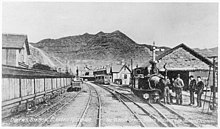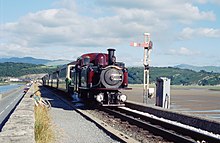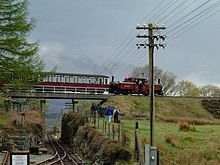Ffestiniog Railway
| Ffestiniog Railway | |||||||||||||||||||||||||||||||||||||||||||||||||||||||||||||||||||||||||||||||||||||||||||||||||||||||||||||||||||||||||||||||||||||||||||||
|---|---|---|---|---|---|---|---|---|---|---|---|---|---|---|---|---|---|---|---|---|---|---|---|---|---|---|---|---|---|---|---|---|---|---|---|---|---|---|---|---|---|---|---|---|---|---|---|---|---|---|---|---|---|---|---|---|---|---|---|---|---|---|---|---|---|---|---|---|---|---|---|---|---|---|---|---|---|---|---|---|---|---|---|---|---|---|---|---|---|---|---|---|---|---|---|---|---|---|---|---|---|---|---|---|---|---|---|---|---|---|---|---|---|---|---|---|---|---|---|---|---|---|---|---|---|---|---|---|---|---|---|---|---|---|---|---|---|---|---|---|---|
|
Tan-y-Bwlch station, around 1900
| |||||||||||||||||||||||||||||||||||||||||||||||||||||||||||||||||||||||||||||||||||||||||||||||||||||||||||||||||||||||||||||||||||||||||||||
| Route length: | 21.93 km | ||||||||||||||||||||||||||||||||||||||||||||||||||||||||||||||||||||||||||||||||||||||||||||||||||||||||||||||||||||||||||||||||||||||||||||
| Gauge : | 597 mm ( narrow gauge ) | ||||||||||||||||||||||||||||||||||||||||||||||||||||||||||||||||||||||||||||||||||||||||||||||||||||||||||||||||||||||||||||||||||||||||||||
| First operation: | 1836-1. August 1946 | ||||||||||||||||||||||||||||||||||||||||||||||||||||||||||||||||||||||||||||||||||||||||||||||||||||||||||||||||||||||||||||||||||||||||||||
| Recommissioning: | 1955-1982 | ||||||||||||||||||||||||||||||||||||||||||||||||||||||||||||||||||||||||||||||||||||||||||||||||||||||||||||||||||||||||||||||||||||||||||||
| Operator: | Festiniog Railway Company | ||||||||||||||||||||||||||||||||||||||||||||||||||||||||||||||||||||||||||||||||||||||||||||||||||||||||||||||||||||||||||||||||||||||||||||
|
|||||||||||||||||||||||||||||||||||||||||||||||||||||||||||||||||||||||||||||||||||||||||||||||||||||||||||||||||||||||||||||||||||||||||||||
The Ffestiniog Railway ( Rheilffordd Ffestiniog in Welsh ) is a narrow-gauge railway with a gauge of 1 ft 11½ in (597 mm), nominally 1 ft 11 5/8 in (600 mm), in County Gwynedd , Welsh . Founded in 1832, it is the oldest active narrow-gauge railway and also the oldest private railway company still in existence in the world.
history
As Europe's cities grew during the Industrial Revolution , so did the need for fireproof roofing material. Slate had proven itself very well for this purpose: Wales had a long tradition in slate mining, as massive deposits were found, particularly in Snowdonia in North Wales. This led to the emergence of numerous local mining centers at the beginning of the 19th century, including Blaenau Ffestiniog , about 20 km from the coast. The fragile slabs of slate were brought down to the valley with pack animals and carts , transferred to small river boats on the Dwyryd and finally loaded onto seaworthy ships on the coast .
At the same time, Wiliam Alexander Madocks , Member of Parliament for Boston , was working on an extensive land reclamation project on the coast of Snowdonia: the construction of a dike cut off the delta of the Glaslyn River from the sea. This dike, called the Treath Mawr Embankment or “the Cob” for short, was completed in 1811. At the northern end of the dam Madocks founded the place Porthmadog and had a port built there. The road over the dike was a welcome shortcut, as it had to be a long detour around the Glaslyn estuary.
The horse tram
However, the means of transport continued to be a limiting factor in slate production. Samuel Holland, owner of a mine near Blaenau Ffestiniog, was able to convince the Dublin businessman Henry Archer in 1829 to invest in a project to develop his mine with a horse-drawn tram , which was approved by parliament on May 23, 1832 (comparable to the granting of a concession ) . The foundation stone for the railway company was laid on February 26, 1833 . The official title that the company still bears today was "Festiniog Railway Company" - with only one "F" - but the Welsh spelling had established itself as the name of the railway in the long term.
A 1 ft 11½ in gauge was chosen, which had already been used in the mines. Gauges of around 2 feet (or approx. 60 cm) had already proven their worth in mining : on the one hand, the distance between the rails was wide enough for a horse , on the other hand, it was sufficiently narrow for narrow tunnels and the smallest arc radii. The route of the railway was worked out by the surveyor James Spooner, who laid out the lines so that there was a constant gradient from the starting point in the mountains to the coast. With one exception, which was replaced by a tunnel at an early stage, he avoided the use of inclined elevators , which would have made operations more complicated. The lowest section of the route led over the dike to the port of Porthmadog.
Thanks to this route, the loaded trains could only be brought down to the valley by gravity . The trains were braked by the brakemen , who traveled on two lorries each with brakes per set. Uphill, workhorses were used as draft animals for the empty wagon trains, which were taken in their own wagons , the so-called "dandy wagons" , on the descent . A descent took about 90 minutes to two hours on the 13.5 mile (approx. 21.5 km) long route, and the horses needed about six hours for the ascent. The timetable provided for six trains per day in each direction, which were divided into four units of eight lorries and one dandy wagon.
This timetable enabled an annual transport capacity of a maximum of 70,000 tons of processed slate.
Steam operation

The railway brought the slate mines around Blaenau Ffestiniog a modern means of transport and the hoped-for economic boom.
The introduction of the now established steam traction was sought after just a few years, but well-known experts such as Robert Stephenson were of the opinion that efficient locomotives could not be built with such a small gauge. Since competition in the form of new standard-gauge lines to Wales advanced in the 1850s, Charles Easton Spooner (James' son), now managing director of the company, commissioned the designer Charles M. Holland (Samuel Holland's nephew) to develop a suitable steam locomotive . After a large number of rejected designs, in 1863 it was used to construct a tender locomotive with a B wheel arrangement, which met the needs of the railway and was ultimately realized in the Hatchham Ironworks by George England.
In July 1863, were the first two locomotives delivered in January and March 1864 and two more in 1867 followed by two more . With them, officially approved passenger traffic on a narrow-gauge railway was started for the first time in 1865. The transport of people on railways with gauges smaller than the standard gauge had been forbidden until then, even if, according to historical reports, isolated people had been transported. The conversion to locomotive operation was a complete success, mainly due to the faster uphill travel of the empty wagon trains. The timetable now provided for a two-hour cycle in both directions, trains going downhill, including passenger cars , continued to roll down into sections dismantled and manned by brakes by gravity, followed by the locomotive running alone. However, this practice was given up after a short time, freight trains hauled down to the valley by a locomotive , equipped with vacuum brakes from 1893 onwards , became the standard. The slate transports, on the other hand, were brought to Porthmadog in block trains by means of gravity until 1939 .
The single-track line stood in the way of the further increase in traffic and the double-track expansion of the railway was therefore approved in 1869. Instead of the highly costly expansion of the line, however, stronger locomotives were used. In 1870 the first of the Robert Francis Fairlie designed locomotives of the Fairlie type with bogies was delivered, which alone was able to produce more than twice the power of a conventional locomotive. By 1886 five machines had been built under the Fairlies patent. Taking into account the increasing demand, investments were also made in the passenger transport fleet, so the Ffestiniog Railway was the first railway company in the British Isles to purchase four-axle passenger coaches with bogies. These wagons, some of which are still preserved in museums, were among the first in the world to have a steel frame.
In addition to articles in railway technology journals, visits to international commissions also made the narrow-gauge railway well known in specialist circles. On the Ffestiniog Railway, proof was provided that even railways with a gauge significantly smaller than the standard gauge are able to perform transport tasks as a full-fledged mode of transport. Inspired by the success of this railroad, narrow-gauge railways were built around the world in the decades that followed.
Decline in the 20th century
With the completion of the competing standard gauge lines of the London and North Western Railway and the Great Western Railway to Blaenau Ffestiniog in the 1870s, the Ffestiniog Railway lost its monopoly in slate transport. At the same time, however, these railway lines brought a significant number of tourists to the region for the first time, who from now on were to become an increasingly important source of income for the narrow-gauge railway. The loss of exports during the First World War , the spread of modern roofing materials from the 1920s and strikes that paralyzed the slate industry caused a sharp decline in freight traffic .
When the British railway system was reorganized in 1923, the FR remained independent as one of the few small railway companies. Also in 1923 a connection with the new Welsh Highland Railway was established in Porthmadog . After its bankruptcy in 1933, it was taken over by the FR, the long travel times over the entire route and the still modest tourism in the region prevented the hoped-for passenger numbers in excursion traffic. In 1937, operations on the Welsh Highland Railway had to be discontinued.
The outbreak of the Second World War led to an abrupt end to excursion traffic and so the last passenger train left on September 15, 1939. Slate was still transported further down the valley on a modest scale. Hopes that freight traffic would recover after the end of the war were not fulfilled, and the mining operations had meanwhile increasingly switched to road transport. On August 1, 1946, the last freight train ran on the Ffestiniog Railway. A nationalization and assumption into Founded in 1948, British Rail no longer took place.
Renaissance as a tourist attraction
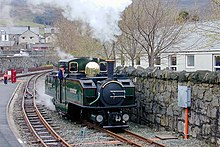
The concession of 1832 did not contain any requirements for a possible shutdown or removal of the line. The company was not dissolved, operations were idle, and vehicles , real estate and tracks were left to decay, vandalism and souvenir hunters.
1951 took place in Bristol a first meeting of railway enthusiasts who were interested in a restart of the railway. By 1954, Alan Pegler (later known for rescuing the A3 Flying Scotsman ) managed to acquire a majority stake in the railway company and to transfer it to a charitable foundation , the Ffestiniog Railway Trust . In September of the same year, a small motor locomotive and a few cars were put into operation for the first time again for public transport, initially only between the port station in Porthmadog and Boston Lodge. A year later, "The Prince" was the first steam locomotive to be reactivated, and further locomotives and cars followed. At Easter 1957, the line to Penrhyn was open again, in 1958 to Tan-y-Bwlch, roughly in the middle of the line.
Since the restart, the company has only been run with a small number of permanent employees, an honorary board of directors and numerous voluntary helpers. The idea that a railway line would be operated by amateurs instead of professional railway workers, largely known in the German-speaking world under the term museum railway , was almost unknown at the time, if not unimaginable. It was not until 1950 that the neighboring Talyllyn Railway opened the world's first railway operation of its kind. Accordingly, it was difficult for the operators to find acceptance and willingness to cooperate with authorities and institutions in the first few years. In particular, a power plant project decided by the British Electricity Authority near Tanygrisiau in 1954, which was built after the railway had been expropriated , stood in the way of an extension to Blaenau Ffestiniog for many years, as part of the route and the Moelwyn tunnel had sunk in a reservoir .
Still striving to fully reactivate the line, the railway sued for damages and unwaveringly opened the next section to Dduallt in 1968. From here, between 1965 and 1978, a three-kilometer-long new line was built in the rocky terrain above the reservoir, including the Dduallt spiral - the only roundabout in the British Isles - and the new, 262 m long Moelwyn, which was built by mining. Tunnels. In its entirety, the project is considered to be the most extensive voluntary construction project in Europe and was mainly financed with donations, grants and loans. In 1971, after 18 years of litigation, the railway company was confirmed its claim for damages and awarded a sum of £ 106,000 for the loss of business.
In 1978 the connection to the original route at Tanygrisiau was restored. Since several bridges had to be renewed in the following section, which was already located within the settlement area of Blaenau Ffestiniog and was comparatively short, and the financial situation was tense after the construction of the new line, the railway depot in Blaenau Ffestiniog was only opened in May 1981 with Glan-y-Pwll reached. One year later, on May 25, 1982 - 150 years after it was founded - the first train finally reached the new Blaenau Ffestiniog station, which was used jointly with the State Railways and was built on the site of the former Great Western Railway station.
After the reopening, the railway company dedicated itself to a large number of other projects that had become necessary to lead the longer route into an economically secure future. For example, early and evening trains with fewer passengers are hauled by diesel locomotives, and a wagon set has also been converted into a push-pull train with a 600 mm gauge. Level crossings were equipped with automatic safety devices and the signaling was modernized. To meet the increasing demand, new wagons and steam locomotives were built in the workshop in Boston Lodge.
As early as the 1970s, steam locomotives were converted to oil firing to avoid fires caused by flying sparks. Due to the sharp rise in fuel prices, however, the 21st century began again to convert to cheaper coal firing with improved spark screens.
There was and still is a significant correlation with the neighboring Welsh Highland Railway, which was rebuilt between 1994 and 2010 under the direction of the Ffestiniog Railway Company . Although there were at times considerable tensions with the original initiators of this project, there is now a cooperative understanding.
Route description
Contrary to the original main transport direction from mountain to valley in freight traffic, the route description of the Ffestiniog Railway traditionally takes place from Porthmadog in the direction of Blaenau Ffestiniog, also in the timetables, which always named this direction of travel first.
The starting point of the train is the port station of Porthmadog. Of the originally more extensive track systems, only those necessary for passenger traffic remained, the docks were abandoned and later built with residential buildings. The station building, the core of which dates from 1879, was expanded and rebuilt several times after traffic was resumed. In 2008/2009, the track system was rebuilt to restore the link with the Welsh Highland Railway.
The exit of the station is located in a right-hand arc, all tracks lead directly to the dike over the Glaslyn estuary, which the railway crosses on the side facing the sea, which is higher than the road. The Boston Lodge Works , depot and main workshop of the railway, are located on the eastern bank , on the site of the quarry that supplied the construction of the dike with material. From here the route runs largely in a north-easterly direction.
After the first three kilometers, Minffordd is reached, the station is the transition station for the standard-gauge Cambrian Line. The freight yard for the mutual exchange of freight is mainly used today as a warehouse for track material . At Penrhyndeudraeth (Penrhyn station), the train reaches the Snowdonia National Park area . The route runs along a wooded slope above the Afon Dwyryd, partly on massive stone retaining walls and dams, the highest of which is the 19 m high Cei Mawr , and further into the Vale of Ffestiniog. From the Plas Halt stop, the train travels down a side valley, giving passengers a view of the small artificial lake Llyn Mair . The Hafod-y-Llyn alternative station was in this section at the time of the horse-drawn tram. From 1873 the crossing stops took place in the Tan-y-Bwlch station, which is more convenient to the local roads and is still used today as a scheduled crossing station. From 1958 to 1968 the trains ended here.
The route now turns back to the Vale of Ffestiniog and passes through the 55 m long Garnedd tunnel, which with its cross-section determines the clearance profile of the railway. The forest population is now noticeably decreasing, the Dduallt station is already located in more open terrain. While the original route ran in a northerly direction, the new line built by volunteers starts at the station in a tight right-hand curve and after a half-turn crosses the track that was recently used on a bridge. After completing the circle, the train is on the slope above the station and continues parallel to the old route and shortly afterwards through the new Moelwyn tunnel. Now further along the banks of the Tanygrisiau reservoir, the route lies in rocky terrain; after the Tanygrisiau station, which was also built in a new location, the track meets the original route again.
Further between the first houses of Blaenau Ffestiniog, the track now runs in an easterly direction to Glan-y-Pwll, the upper depot of the railway. The original main line ran from here further east to Dinas train station, where the loaded lorries were carried down from the slate quarries by inclined elevators . In Glan-y-Pwll a line branched off to the south, which ended at Duffws station, the freight was brought in here as in Dinas with inclined lifts. The first passenger trains ended in Dinas in 1865, from 1866 both stations were served alternately and from 1870 all passenger trains ended in Duffws. The transition stations to the standard gauge lines of the London and North Western Railway and the Great Western Railway were built on the southern branch, both of which ended in their own terminal stations and were only connected to one another in 1964 after a section of the southern line, which had been closed in 1961, was reactivated as a feeder to the Trawsfynydd nuclear power station has been. Between 1868 and 1883, the narrow-gauge Festiniog and Blaenau Railway branched off in front of Duffws and served as a feeder to quarries near Tanymanod and the town of Llan Ffestiniog. The standard gauge line of the Great Western Railway was built on the route of this railway from 1882.
The Blaenau Ffestiniog station shared by Ffestiniog Railway and the Conwy Valley Line of British Rail (now Arriva Trains Wales), which opened in 1982, was built on the site of the original Great Western station. The continuation to Duffws station and the branch to Dinas no longer exist today.
Importance for tourism
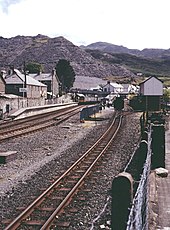
The first indications of a tourist use of the narrow-gauge railway can be found in a travel guide for the London and North Western Railway from 1876. However, tourism did not gain any economic relevance for the company until the interwar period of the 20th century. With the decline of the freight traffic it became one of the most important branches of the company and its failure with the outbreak of the Second World War led to the cessation of operations. The company, which was re-established in the 1950s, is in keeping with its nature as a Heritage Railway (the British equivalent of the term "museum railway"), and is completely geared towards tourist passengers.
Today, the Ffestiniog Railway is at the top of every Welsh attraction rankings . The importance of the railways to tourism in Wales has been recognized several times by relevant institutions such as the Wales Tourist Board in the form of sponsorship awards and financial contributions.
Following the touristic character of the company, the travel agency Ffestiniog Travel was founded in the 1960s, specializing in group trips to travel destinations for rail enthusiasts.
The railway is a member of the Great Little Trains of Wales .
literature
- James IC Boyd: Narrow Gauge Railways in South Caernarvonshire - Vol. 1. The Oakwood Press 1988, ISBN 0-85361-365-6 .
- James IC Boyd: The Festiniog Railway 1800-1974; Vol. 1 - History and Route. The Oakwood Press 1975, ISBN 0-85361-167-X .
- James IC Boyd: The Festiniog Railway 1800-1974; Vol. 2 - Locomotives and Rolling Stock; Quarries and Branches: Rebirth 1954-74. The Oakwood Press 1975, ISBN 0-85361-168-8 .
- Ffestiniog Railway Company (self-published): Ffestiniog Railway Traveller's Guide
- Chris Jones, Peter Dennis: Little Giants - A history of the Ffestiniog Railway's pre-revival locomotives, their mentors, manufacture and maintenance . Lightmoor Press, Lydney, Gloucestershire 2018, ISBN 978-1-911038-43-6 (English).
- Peter Johnson: Immortal Rails. The Story of the Closure and Revival of the Ffestiniog Railway 1939-1983 . 2 volumes. RailRomances, Chester 2004-2005, (Volume 1: 1939-1964 . ISBN 1-900622-08-4 ; Volume 2: 1964-1983 . ISBN 1-900622-09-2 ).
- Peter Johnson: An illustrated history of the Festiniog Railway. Oxford Publishing Co. 2007, ISBN 978-0-86093-603-9 .
- John R. Jones: The great little steam railways of Wales . Commentary by Anthony Pritchard. Aston, Bourne End 1991, ISBN 0-946627-64-9 .
- Richard Koch: About narrow-gauge railways for passenger and freight traffic. Messages about such railways in North Wales, especially about the Festiniog Bahn . In: W (ilhelm Otto) Hostmann (Hrsg.), Richard Koch (Hrsg.): Journal for the entire local and tram system: notifications about local railways, especially narrow-gauge railways . First vintage. Bergmann, Wiesbaden 1882, pp. 9-25. - Full text online .
- PJG Ransomware: Narrow Gauge Steam. Its origins and world-wide development . Yeovil, Oxford 1996, ISBN 0-86093-533-7 .
- Richards Robin: The Great Little Trains of Wales . Celtic Educational Services, Cardiff, 1991, ISBN 0-86005-017-3 .
- Patrick Whitehouse, John Snell: Narrow Gauge Railways of the British Isles . 2nd Edition. David & Charles, Newton Abbot 1994, ISBN 0-7153-0196-9 .
Web links
- Homepage of the Ffestiniog Railway
- The Ffestiniog Railway Society
- The Festiniog Railway Heritage Group
- Welsh Highland Railway
- Ffestiniog Railway - Driver's Eye View - Blaenau Ffestiniog to Porthmadog (Wales) . Video of the complete route of the Ffestiniog Railway from Blaenau Ffestiniog station to Porthmadog Harbor (as of July 2017), recorded from the bow of the Fairlie locomotive Merddin Emris (YouTube video, running time 55:27, accessed on July 17, 2017).
Individual evidence
- ^ History - Ffestiniog Railway / Part 2 - The Fairlie Solution. Retrieved January 8, 2012 .
- ^ History - Ffestiniog Railway / Part 4 - The Great Deviation. Retrieved January 8, 2012 .
Coordinates: 52 ° 59 ′ 39 ″ N , 3 ° 56 ′ 15 ″ W.





